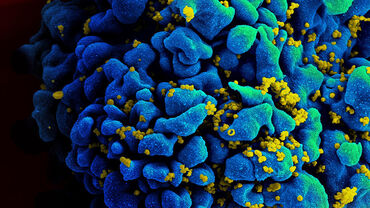The benefits of HIV treatment: undetectable means you do not pass on the virus
Since its introduction in the 1990s, the main aim of combination antiretroviral therapy (ART) for HIV has been to halt the progression of the infection, maintaining the health of the HIV-positive person taking treatment. In addition to this, the impact of treatment as prevention has been well described.
One outcome of an effective ART regimen is that it markedly supresses the amount of the virus circulating in the blood – the so-called ‘viral load’ – to a very low level, so that the virus is no longer detectable during routine testing. Successful ART not only improves the health and lifespan of the person living with HIV and receiving treatment, but there is growing scientific consensus that effective ART, leading to viral suppression, also means that onward transmission of HIV is practically no longer possible.
This consensus in the scientific community builds on results from large multi-national research studies, which involved both heterosexual and homosexual couples in which one partner was HIV-positive. These studies followed the couples over time and found no transmission from virally suppressed HIV-positive persons to their HIV-negative partner. Study results indicate that an undetectable viral load practically eliminates the risk of someone transmitting HIV once viral suppression has been achieved and maintained. These findings have now been validated by the results of the PARTNER2 study, which followed 1 000 gay male discordant couples between 2010 and 2018 and found no linked HIV transmission despite sex without condoms.
In general, viral suppression, and with it an undetectable viral load, can be reached within six months of starting daily ART.
ECDC comment: prevention benefits of viral suppression
The encouraging PARTNER2 study results give further impulse on the way towards the global target of ending AIDS by 2030. They can particularly address and help reduce HIV-related stigma, both among HIV-positive people as well as the public, by reinforcing the message: people living with HIV who are on effective ART do not pass on the virus.
In fact, achieving and maintaining an undetectable viral load serves as a very effective prevention method to help interrupt existing transmission chains. This applies for gay men as well as heterosexual couples.
However, reaching and maintaining an undetectable viral load is just one step in the socalled HIV continuum of care. Effective HIV treatment depends on being diagnosed and starting treatment early and adhering to it closely – at a time when an estimated 11-17% of people living with HIV in the European Union and European Economic area are not even aware of their infection and thus not receiving treatment and care. Retention in care is essential to improve adherence and to monitor the health of people who are on HIV treatment correctly.
In addition, it is important to bear in mind that while viral suppression means the virus is undetectable in the blood, HIV is only dormant at this stage but still present in the body. Any interruption of the treatment regimen results in viral rebound - making strict adherence to treatment essential. Even with good adherence the virus might rebound due to the emergence of resistance, so regular viral load testing is important to confirm viral suppression.
The consistent use of condoms remains necessary to prevent the transmission of other sexually transmitted infections as these are not prevented by HIV treatment or by using HIV pre-exposure prophylaxis (PrEP).
The tools to end HIV and AIDS already exist; however, countries of the European Union and European Area (EU/EEA) have seen a persistent HIV epidemic with only minimal changes in notification rates over the last decade. ECDC will continue to closely follow the research developments to be able to provide further scientific and technical support to the European Commission and the Member States to help ensure the success of their HIV response strategies.
Read more on external websites
Reduction in undiagnosed HIV infection in the European Union/European Economic Area, 2012 to 2016





